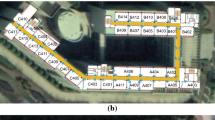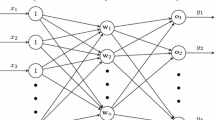Abstract
Indoor positioning methods make it possible to estimate the location of a mobile object in a building. Many of these methods rely on fingerprinting approach. First, signal strength data is collected in a number of reference indoor locations. Frequently, the vectors of the strength of the signals emitted by WiFi access points acquired in this way are used to train machine learning models, including instance-based models.
In this study, we address the problem of signal strength data acquisition to verify whether different strategies of selecting signal strength data for model testing are equivalent. In the analysed case, the content of a testing data set can be created in a variety of ways. First of all, leave-one-out approach can be adopted. Alternatively, data from randomly selected points or same grid points can be used to estimate method accuracy. We show which of these and other approaches yield different accuracy estimates and in which cases these differences are statistically significant. Our study extends previous studies on analysing the performance of indoor positioning systems. At the same time, it illustrates an interesting problem of testing data acquisition and balancing the conflicting needs of collecting testing data in similar, yet different conditions compared to how training data was acquired.
Access this chapter
Tax calculation will be finalised at checkout
Purchases are for personal use only
Similar content being viewed by others
References
Dawes, B., Chin, K.W.: A comparison of deterministic and probabilistic methods for indoor localization. J. Syst. Softw. 84, 442–451 (2011)
Fang, S.H., Lin, T.N., Lin, P.: Location fingerprinting in a decorrelated space. IEEE Trans. Knowl. Data Eng. 20(5), 685–691 (2008)
Flach, P.: Machine Learning: The Art and Science of Algorithms That Make Sense of Data. Cambridge University Press, New York (2012)
Grzenda, M.: Reduction of signal strength data for fingerprinting-based indoor positioning. In: Jackowski, K., Burduk, R., Walkowiak, K., Woźniak, M., Yin, H. (eds.) IDEAL 2015. LNCS, vol. 9375, pp. 387–394. Springer, Cham (2015). https://doi.org/10.1007/978-3-319-24834-9_45
Japkowicz, N., Shah, M.: Evaluating Learning Algorithms: A Classification Perspective. Cambridge University Press, New York (2011)
Jin, Y., Soh, W.S., Wong, W.C.: Error analysis for fingerprint-based localisation. IEEE Commun. Lett. 14(5), 393–395 (2010)
Khalajmehrabadi, A., Gatsis, N., Akopian, D.: Modern WLAN fingerprinting indoor positioning methods and deployment challenges. IEEE Commun. Surv. Tutor. 19(3), 1974–2002 (2017). https://doi.org/10.1109/COMST.2017.2671454. Thirdquarter
Kjargaard, M.B.: Indoor location fingerprinting with heterogeneous clients. Pervasive Mobile Comput. 7, 31–43 (2011)
Lee, M.K., Han, D.S.: Dimensionality reduction of radio map with nonlinear autoencoder. Electron. Lett. 48(11), 655–657 (2012)
Lemic, F., Behboodi, A., Handziski, V., Wolisz, A.: Experimental decomposition of the performance of fingerprinting-based localization algorithms. In: 2014 International Conference on Indoor Positioning and Indoor Navigation (IPIN), pp. 355–364, October 2014. https://doi.org/10.1109/IPIN.2014.7275503
Álvarez López, Y., de Cos Gómez, M.E., Álvarez, J.L., Andrés, F.L.H.: Evaluation of an RSS-based indoor location system. Sens. Actuators A Phys. 167(1), 110–116 (2017). https://doi.org/10.1016/j.sna.2011.02.037. http://www.sciencedirect.com/science/article/pii/S0924424711000999
Luo, X., O’Brien, W.J., Julien, C.L.: Comparative evaluation of Received Signal-Strength Index (RSSI) based indoor localization techniques for construction jobsites. Adv. Eng. Inf. 25, 355–363 (2011)
Moghtadaiee, V., Dempster, A.G.: Design protocol and performance analysis of indoor fingerprinting positioning systems. Phys. Commun. 13(PA), 17–30 (2014). https://doi.org/10.1016/j.phycom.2014.02.004
Tao, Y., Zhao, L.: A novel system for WiFi radio map automatic adaptation and indoor positioning. IEEE Trans. Veh. Technol. 67, 10683–10692 (2018). https://doi.org/10.1109/TVT.2018.2867065
Visbrot, R., Kozinsky, A., Freedman, A., Reichman, A., Blaunstein, N.: Measurement campaign to determine and validate outdoor to indoor penetration models for GSM signals in various environments. In: 2011 IEEE International Conference on Microwaves, Communications, Antennas and Electronic Systems (COMCAS 2011), pp. 1–5, November 2011. https://doi.org/10.1109/COMCAS.2011.6105823
Yang, Q., Pan, S.J., Zheng, V.W.: Estimating location using Wi-Fi. IEEE Intell. Syst. 23(1), 8–13 (2008)
Acknowledgements
This research was partly supported by the National Centre for Research and Development, grant No. PBS2/B3/24/2014, app. no. 208921.
Author information
Authors and Affiliations
Corresponding author
Editor information
Editors and Affiliations
Rights and permissions
Copyright information
© 2019 Springer Nature Switzerland AG
About this paper
Cite this paper
Grzenda, M. (2019). Analysing the Performance of Fingerprinting-Based Indoor Positioning: The Non-trivial Case of Testing Data Selection. In: Wotawa, F., Friedrich, G., Pill, I., Koitz-Hristov, R., Ali, M. (eds) Advances and Trends in Artificial Intelligence. From Theory to Practice. IEA/AIE 2019. Lecture Notes in Computer Science(), vol 11606. Springer, Cham. https://doi.org/10.1007/978-3-030-22999-3_40
Download citation
DOI: https://doi.org/10.1007/978-3-030-22999-3_40
Published:
Publisher Name: Springer, Cham
Print ISBN: 978-3-030-22998-6
Online ISBN: 978-3-030-22999-3
eBook Packages: Computer ScienceComputer Science (R0)




